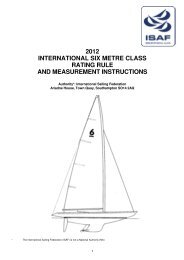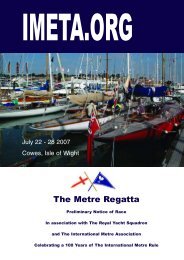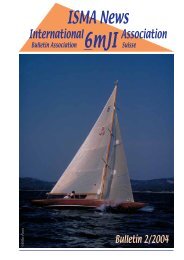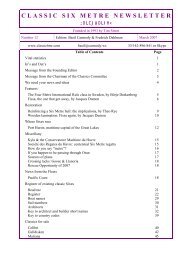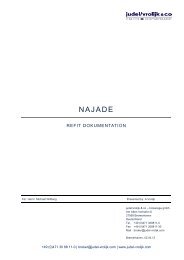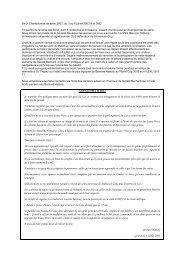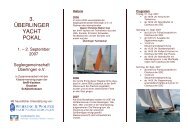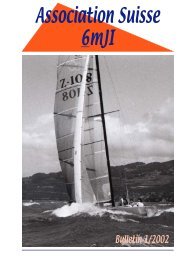ISMA News - Association Suisse 6mJI
ISMA News - Association Suisse 6mJI
ISMA News - Association Suisse 6mJI
Create successful ePaper yourself
Turn your PDF publications into a flip-book with our unique Google optimized e-Paper software.
<strong>ISMA</strong> <strong>News</strong> International <strong>6mJI</strong> <strong>Association</strong> Bulletin 1/2004<br />
The metric rule<br />
We have the chance to reprint a very interesting report about the metric rule development, which has been edited by our<br />
Chief Measurer, Guy-Roland Perrin, and published in French and UK Magazines before.<br />
The metric rule<br />
To write about the meter class measurement rule makes me feel a little pretentious. Of course these formulas, these<br />
measurement instructions are familiar to me, but before starting these lines I felt necessary to go back to the basic, to go<br />
back to the rule and the literature left back by several historians, naval architects from the beginning of the century or<br />
even specialist of the meter rule such as the former IYRU technical chief, Tony Watts. The all story is almost a story of<br />
mad, a continuous dispute between Great-Britain, France and USA.<br />
Everything started at the end of the last century. Great Britain was still mastering … and ruling the sailing as a sport. In<br />
the middle of the IX X century winning a yacht race was essentially due to the size of the yacht and the amount of sail she<br />
was able to carry… this was not really what one could name “fair competition”. Several Yacht Clubs, you know what I<br />
mean, these nice places on the see shore populated only by gentlemen, decided to discuss the feasibility of a rating rule<br />
allowing yacht of different size to compete together in a fair competition. This was the beginning of the trouble.<br />
At that period there was only one rule, a single denominator, across the different nations: the rule used by the custom to<br />
evaluate the volume of goods arriving by sea in a country.<br />
Tonnage =<br />
L x B x H<br />
96<br />
L= Longueur de coque<br />
B= Bau maximum<br />
H= Profondeur de coque<br />
The willingness to compete together for the yachtsmen (the gentlemen from the club!), as well as for the architects and<br />
the engineers grows, and step by step the key elements characterising a sailing yacht have been included in the various<br />
formulas. The length, the beam, the draught were the first components of the rule, ignoring totally the sail area. If the<br />
desire to reach a single formula was shared across the oceans, the rules, even (specially!) across the Channel were<br />
different, each of them giving advantages to the local architects. Great Britain was well known for narrow and deep yacht<br />
(the beam , stability of hull shape, was heavily penalised), when USA was in favour of the sandbaggers, with large beam,<br />
almost no draught and including moving ballast (that often was not anymore on the boat at the arrival of the race!)<br />
Huge bowsprit and boom, not to mention the mast, fit these yachts, allowing them to carry impressive and free (from a<br />
rule perspective) sail area.<br />
That “error” led the gentlemen of the yachting of the end of the past century to think again to their respective rules, and<br />
between 1886 and 1890 to include a factor proportional to the sail area.<br />
In no time the architects react, and the displacement being absent of these formulas, they designed boats as light as<br />
possible (life expectancy was about a season).<br />
With these several experiences the ground was ready for the future linear meter rule, but the consensus among the<br />
international yachtsmen was far to be reached, and competing (and great) classes such as the “sonderklasse” and the<br />
6.5m were trying desperately to impose themselves. Still today one may ask itself what has allowed the meter rule to<br />
impose itself and last so long.<br />
Jauge linéaire =<br />
L + B + 0.75 G + 0.5 SQR(SA)<br />
L = Longueur de flottaison "dynamique"<br />
B = Bau maximum<br />
G = Périmètre de la carêne à "mid-ship"<br />
SQR (SA) = racine carrée de la surface vélique<br />
2<br />
57



